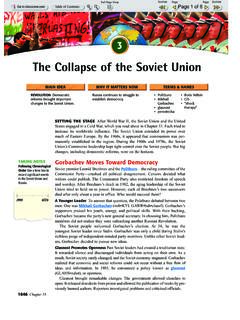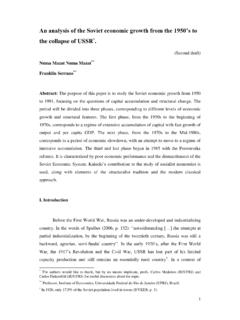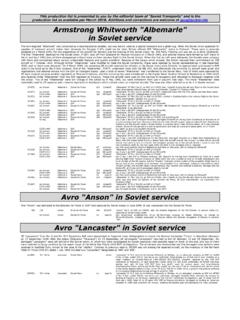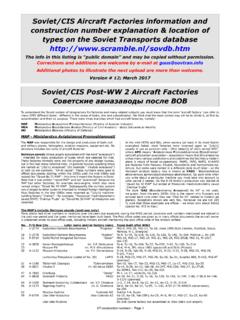Transcription of GENERAL EFFECTIVE DATE UNDER ARTICLE XIII: 1 JANUARY …
1 CONVENTION WITH THE UNION OF soviet SOCIALIST REPUBLICSON MATTERS OF TAXATIONC onvention, with Related Letters, Signed at Washington June 20, 1973;Ratification Advised by the Senate of the United States of America December 15, 1975;Ratified by the President of the United States of America December 17, 1975;Ratified by the Union of soviet Socialist Republics December 24, 1975;Ratifications Exchanged at Moscow December 30, 1975;Proclaimed by the President of the United States of America JANUARY 22, 1976;Entered into Force JANUARY 29, 1976; EFFECTIVE JANUARY 1, EFFECTIVE DATE UNDER ARTICLE XIII: 1 JANUARY 1976 TABLE OF ARTICLESA rticle 1---------------------------------Taxes CoveredArticle II---------------------------------Gener al DefinitionsArticle III--------------------------------Incom e Subject to TaxArticle IV--------------------------------Income of RepresentationArticle V---------------------------------Shippi ng and AircraftArticle VI--------------------------------Exempt ionsArticle VII------------------------------ Taxation on CitizensArticle VIII------------------------------Applic ation of TreatyArticle IX--------------------------------Exempt ion of Transaction Giving Rise to Exempt IncomeArticle X---------------------------------Non-Di scriminationArticle
2 XI--------------------------------Mutual Agreement ProcedureArticle XII-------------------------------Exchan ge of InformationArticle XIII------------------------------Entry into ForceArticle XIV------------------------------Termina tionNotes of Exchange----------------------of 20 June, 1973 Letter of Submittal ---------------------of 10 September, 1973 Letter of Transmittal--------------------of 19 September, 1973 The Saving Clause -------------------- ARTICLE VIIMESSAGEFROMTHE PRESIDENT OF THE UNITED STATESTRANSMITTINGTHE CONVENTION BETWEEN THE UNITED STATES OF AMERICA ANDTHE UNION OF soviet SOCIALIST REPUBLICS ON MATTERS OF TAXATION,WITH RELATED LETTERS, SIGNED AT WASHINGTON ON JUNE 20, 1973 LETTER OF SUBMITTALDEPARTMENT OF STATE,Washington, September10, PRESIDENT,The White House.
3 THE PRESIDENT: I have the honor to submit to you, with a view to its transmission to the Senatefor advice and consent to ratification, the Convention between the United States of America and theUnion of soviet Socialist Republics on Matters of Taxation, with related letters, signed at Washingtonon June 20, 1973. The Convention was formulated as a result of technical discussions between officials of thisGovernment and officials of the Government of the Union of soviet Socialist Republics. The Departmentof State and the Department of the Treasury cooperated in the negotiation of this Convention and it hasthe approval of both Departments. The primary purpose of this Convention is to promote economic and cultural relations between thetwo countries by eliminating tax barriers to the extent possible.
4 The Convention deals primarily withtaxes at the Federal level in the case of the United States and with All-Union taxes in the case of theSoviet Union. Because of limited contact in the past, the citizens and commercial enterprises of each country havehad little exposure to the tax system of the other country. Taking into account the tax problems whichare likely to arise in conjunction with less restricted intercourse between the two countries, theConvention outlines the circumstances UNDER which each country may tax the business firms of, andvisitors from, the other country. The GENERAL content of the Convention is similar to conventions between the United States and othercountries on the avoidance of double taxation on income.
5 However, because of the dissimilaritiesbetween the taxation systems of the two countries, in this Convention somewhat more emphasis thanusual is given to tax exemptions. Examples of the types of payments made between the two countrieswhich will be exempt from taxation in the source country are: (a) rentals or royalties for the use ofpatents, copyrights, equipment, and know-how; (b) payments for engineering, architectural, and othertechnical services; (c) interest on indebtedness in connection with the financing of trade between the twocountries; (d) reinsurance premiums; and (e) income from the sale of goods effected through acommission agent. The Convention provides reciprocal exemption from tax for shipping and aircraft operations.
6 It alsoprovides that an individual will be exempt from tax on income from personal services if he is present inthe host State for six months or less, and will be exempt for longer periods if he falls into a specifiedcategory such as teacher or student. In the case of students, the exemption may be for as long as fiveyears. The Convention departs from the pattern of the usual tax convention in its provisions relating tospecified types of business income and to the earnings of newspaper, radio and TV , United States treaties provide that a foreign firm having a place of business in the UnitedStates continues to be subject to tax on business profits "effectively connected" with the United Statesplace of business; otherwise, the income is often exempt.
7 The same principle applies in this Convention,but income from several types of activity is exempt whether or not the soviet or United States enterprisehas a place of business in the other country. One such exemption is income from sales through a into account the soviet system, income of United States companies from sales to soviet TradingOrganizations will be treated as tax exempt income from sales through a broker. The reciprocal two-year income tax exemption granted journalists and correspondents in this Convention is a departurefrom prior practice made to accommodate one of the principal soviet desiderata. At present, the soviet tax structure is less developed in respect to foreign entities and persons thanis the United States tax structure.
8 United States tax rates on individual income, especially for employedpersons, are presently generally higher than those in the soviet Union. Further, United States companiesdealing with the soviet Union, according to available information, have generally dealt adequately withpotential taxation in their agreements with soviet trading organizations. As a result of these factors, thepresent tax benefits of this Convention will appear to be more in favor of the soviet Union. However,the Convention provides a significant potential benefit for the United States and its citizens in limiting thetax impact of the expected development of the soviet tax system, which is almost certain to treat foreignpersons and entities on the basis of reciprocity.
9 Further the Convention contains a non-discriminationclause which should provide significant protection to United States interests. Through its system ofexemptions, the Convention should largely insulate the entities and citizens of the parties from income taxin the other state. As with most tax conventions, a principal benefit is to free to a great extent thecompanies and persons involved from the compliance and administrative problems of dealing with aforeign tax system. This, in turn, can be expected to contribute to the smooth development of UnitedStates- soviet Union trade, cooperation, and exchanges. This Convention enters into force thirty days after the exchange of instruments of ratification.
10 Theprovisions of the Convention shall, however, have effect for income derived on or after JANUARY 1 of theyear following the year in which the instruments or ratification are exchanged. The Convention willremain in effect for a minimum of three years after which it will continue in effect indefinitely, but maythen be terminated by either country by notice given at least six months before the end of any calendaryear. A technical memorandum explaining the principal features of this Convention is being prepared bythe Department of the Treasury for the use of the Senate. It is hoped that the Senate will consider andapprove this Convention at an early date. Respectfully submitted,KENNETH RUSH,Acting Secretary of : OF TRANSMITTALTHE WHITE HOUSE, September 19, the Senate of the United States: With a view to receiving the advice and consent of the Senate to ratification, I transmit herewith theConvention between the United States of America and the Union of soviet Socialist Republics onMatters of Taxation, with related letters, signed at Washington on June 20, 1973.



















